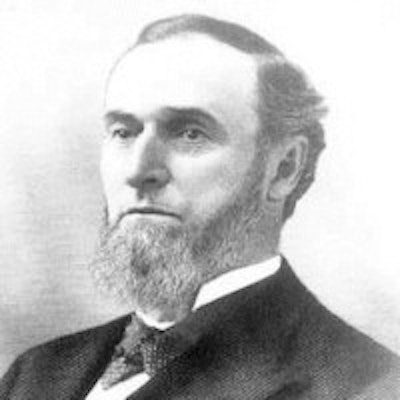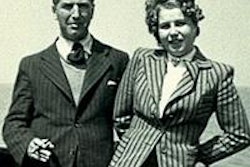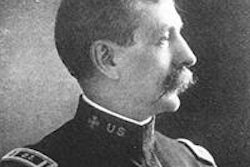
Minutes after the first electric chair execution in the summer of 1890, Dr. Alfred Southwick, a Buffalo, NY, dentist, proudly told the assemblage of witnesses, "This is the culmination of 10 years work and study! We live in a higher civilization."
The execution had taken a mere 17 seconds. A few moments later though, the prison warden noticed the prisoner's "chest begin to heave," and another screamed, "Oh my God! He's breathing!" The warden ordered the current restarted. It took two minutes for the full charge of 2,000 volts to rebuild while the prisoner gulped for breath. Several witnesses left the room as the prisoner frothed at the mouth and moaned. "Smoke became visible" coming from the top of his head, and "the smell of burning flesh" filled the room. It took another 70 seconds before the current was finally cut off and the prisoner declared dead.
 Dr. Alfred Southwick (1826-1898).
Dr. Alfred Southwick (1826-1898).
It was a ghastly beginning that produced sensational headlines the world over. Using electricity had been touted by Dr. Southwick, dubbed the father of the electric chair, as "painless and quick."
Later that day, Dr. Southwick insisted to a New York Herald reporter that the inmate had died "an absolutely painless death." He continued, "Not a cry from the subject. Not a sound. [He] died without knowing anything about it."
The nation's press though, disbelieving this version of the facts, roundly condemned the agonizing death. For example, New Jersey's Camden Chronicle editorialized, "the world is horrified. ... The electricity was turned on three times before the man was killed. The breath heaved; the nails cut into the flesh; the flesh sizzled and smoked, and was burned into a crisp; the clothing caught on fire, and one of the witnesses fainted." The editorial concluded, "If it is desirable to tincture executions with the milk of human kindness in the taking off of criminals, let us retain the old method of hanging by the neck."
Dr. Southwick had worked for a decade to change the national mode of execution from hanging and firing squad to electrocution. According to the Wichita Daily Eagle, he had advocated electrocution "in the interests of humanity and mercy." His sincere desire, according to the New York Tribune, was that hanging, a "cruel and clumsy method of execution," should "be relegated among the other barbarisms of punishment, which belong to a harsher age than the present."
Alfred Porter Southwick was born in 1826 in Ohio into a prominent family whose heritage dated back to the Mayflower. After graduating from high school, he found work in Buffalo, NY, servicing ship engines. In 1853, he married Mary Flynn. The couple adopted a daughter -- their only child. That same year, he was appointed chief engineer for another steamboat company. According to an article by David Marc in the American National Biography Online, the promotion was unusual because it normally "required formal study in engineering." He published a number of scholarly articles on nautical steam engine design and, according to Marc, "participated in scientific discussion groups."
In 1859, he attended the founding convention of the American Dental Association in nearby Niagara Falls. Marc reports that Southwick saw an opportunity to "develop new tools and mechanical devices" that would aid dentistry. Shortly after the convention, he apprenticed himself to a local dentist, eventually opening his own practice in downtown Buffalo. Marc relates that Dr. Southwick saw "patients by day and [pursued] research projects after hours." He successfully designed an implant for cleft palates, and in 1877 his achievement was recognized by the New York Dental Association.
Around 1880, the inventive Dr. Southwick became interested in low-voltage electricity as a possible pain numbing agent during dental treatment. In 1881, a drunken dockworker attempting to shut down a light and power plant dynamo in Buffalo was electrocuted. The event was widely reported and caught the dentist's attention -- thinking it might be a more "humane" method for capital punishment executions. According to some reports, since Dr. Southwick was accustomed to performing procedures on his patients in a dental chair, he came up with the idea of using an electric chair for executions.
Personally, Southwick was a proponent of capital punishment but was troubled by universal reports of bungled hangings. The nation's newspapers reported widespread problems with hangings, using descriptive words and phrases such as "writhing and suffering," "convulsions," "throes," "contortions," "fractures," and even "heads being ripped off of victims' bodies." Death penalty advocates were fearful that the U. S. Supreme Court would eventually abolish hanging as "cruel and unusual punishment," and with it the death penalty altogether.
Dr. Southwick, along with a physician friend, began experimenting by electrocuting animals. They were having difficulty in determining the right amount of voltage, so they contacted Thomas Edison for his help. Edison was opposed to the death penalty and advised Dr. Southwick to contact George Westinghouse.
Many believe Edison used the debate as a ploy to gain influence against Westinghouse's alternating current (AC) system, which was in direct competition to Edison's own patented direct current (DC) system. Edison, ever the grandstander and promoter, claimed Westinghouse's AC was too dangerous to be used to transport electricity to residences and businesses. The so-called "current wars" became so intense that Edison electrocuted an elephant to demonstrate the danger of AC, even filming the macabre event and distributing it to movie houses all over the U.S. The circus elephant, Topsy, had killed a trainer and was deemed a danger to people.
 William Kemmler was the first person executed using an electric chair on August 6, 1890, at Auburn Prison in New York.
William Kemmler was the first person executed using an electric chair on August 6, 1890, at Auburn Prison in New York.
Because of Westinghouse's involvement with Dr. Southwick, Edison publicly scorned Westinghouse and referred to electrocutions of death row inmates as being "Westinghoused," a moniker that lasted for decades.
Dr. Southwick talked up his belief and experiments with one of his patients, a state senator, who in turn relayed the information to several prominent public officials, including Gov. David Hill, who had just succeeded Gov. Grover Cleveland after Cleveland's election to the U.S. presidency. Hill, also mortified by the growing public outrage over bungled hangings, created a three-member commission to study the question of alternatives to hanging. Dr. Southwick was appointed one of its members.
The commission issued its report the same year. The report, a well-written, historic treatise on executions dating back to ancient times, reported that "all primitive forms of capital punishment ... [were] ... characterized by cruelty ... all expressing ... an intense desire to wreak vengeance ... a desire to inflict physical pain and suffering, even the utmost agony possible." By the mid-1800s, according to the report, civilization had advanced to a point where executions had evolved to be "speedier and more merciful" than ancient times. The next logical step would be electrocution an instantaneous and merciful method of execution. In 1888, as part of the report, the commission surveyed 36 nations' modes of execution, finding that 10 used the guillotine, 19 used a sword, three used gallows (hanging), two used firing squads, one used an axe, and one used a garrote cord for strangulation.
A result of the report was that the New York Legislature, following the governor's request, enacted legislation that legalized electrocution in New York state.
 New York abandoned the chair in 1963 when state courts ruled it as "cruel and unusual punishment."
New York abandoned the chair in 1963 when state courts ruled it as "cruel and unusual punishment."
In the background, Edison continued to plot by secretly funding Harold Brown, another inventor who developed the AC electric chair. New York purchased and used Brown's electric chair in the first electrocution. Edison must have been gleeful of the debacle as sensationalized in the newspaper reports, but to no avail. According to Marc, by 1950, "twenty-seven states and the District of Columbia, as well as more than a dozen countries around the world, executed all or some of their capital-case prisoners with the electric chairs."
New York abandoned the chair in 1963 when state courts ruled it as "cruel and unusual punishment." This was ironic, since avoidance of cruel and unusual punishment was one of the primary reasons the chair was developed by Dr. Southwick in the first place.
In 1892, Dr. Southwick became a professor at the newly formed dental school at the University of Buffalo. Marc relates that Dr. Southwick "was dogged by a reputation as a political propagandist for capital punishment" for the rest of his life. The New York State Dental Society refused to recognize the dental school because Southwick only held an "honorific degree conferred by colleagues," which Marc contends "singled out [Dr. Southwick] for embarrassment by a death penalty critic."
Dr. Southwick died at his home in Buffalo in June 1898. He was 72.
Daniel Demers is a semiretired businessman whose hobby is researching and writing about 19th and 20th century historical events and personalities. He holds a bachelor's degree in history from George Washington University and a master's degree in business from Chapman University. You can review his other published works at www.danieldemers.com.
Sources
Articles/books
Life for life. Wichita Daily Eagle. May 31, 1890:2. Accessed March 2, 2014.
Macleod M. The electric chair: The curious dentist. Crime Library website. Accessed February 26, 2013.
A new agent of death. New York Tribune. January 22, 1888:4. Accessed March 2, 2014.
New York State Commission on Capital Punishment. Report of the commission to investigate and report the most humane and practical method of caring into effect the sentence of death in capital cases. January 17, 1888. Accessed March 2, 2014.
A plan proposed. Great Falls Leader. December 13, 1888:1. Accessed March 3, 2014.
William Kemmler electrocuted. Camden Chronicle. August 8, 1890:2 Accessed March 7, 2014.
Websites
Alfred Southwick. Wikipedia website. Accessed March 1, 2014.
Electrocuting an elephant. You Tube website. Accessed March 4, 2014.
Marc D. Southwick, Alfred Porter. American National Biography Online website. February 2000. Accessed February 26, 2014.
Spagnoli F. Annals of heartlessness (10): "Let's invent execution by electrocution as a way to settle some business differences." P.A.P.-Blog//Human Rights, Etc. website. October 25, 2011. Accessed March 3, 2014.
Topsy (elephant). Wikipedia website. Access March 4, 2014.



















